The Diverse Applications of Crystals Explained
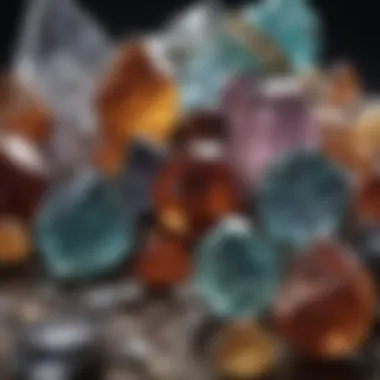
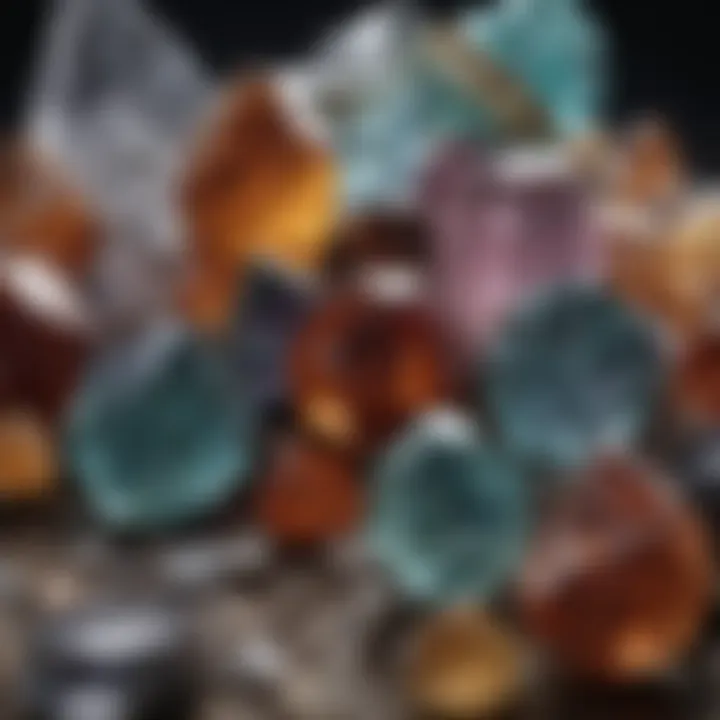
Intro
Crystals have intrigued humankind for centuries, drawing interest for their stunning aesthetics and perceived powers. From everyday enthusiasts to avid collectors, these unique formations hold a special place in many hearts. But there's more to crystals than simply their looks. Today, we take a closer look at the range of uses that crystals offer, going beyond the sparkle to delve into their historical roots, practical applications in various fields, and contemporary significance.
Recognizing the multifaceted role of crystals requires an understanding that touches on history, science, and culture. This article aims to open the eyes of rock and fossil collectors, helping them appreciate the depth of these natural wonders.
History and Origins
Overview of Collectibles, Rocks, and Fossils
Long before they became the shiny decorations we find today, crystals were revered by ancient civilizations. Early on, people recognized their value not only for adornment but also for their purported healing properties. Many cultures, from the Greeks to the Egyptians, incorporated crystals into rituals, believing that they could ward off evil or bring good fortune.
The fascination didn’t stop at the ancient world; throughout history, the quest for rare and beautiful crystals fueled exploration and trade. Collectors sought after specimens that were rare, beautiful, and believed to have special powers.
Historical Significance and Cultural Impact
Crystals have played varied roles throughout human history. In the Middle Ages, for instance, many believed that certain stones had the ability to heal ailments or act as talismans. Different cultures had their unique interpretations and uses for crystals. Jade was treasured in China; turquoise had significant importance among Native Americans, while in India, people cherished diamonds as symbols of wealth and power.
The significance of these natural formations goes well beyond personal uses. Crystals have influenced art, literature, and even commerce. Cultures across the world have woven the presence of these stones into their beliefs, setting the stage for modern practices surrounding crystals.
"Crystals have a rich narrative that spans across time and space, echoing human experience and belief systems."
Identification and Classification
Guide to Identifying Rocks and Fossils
When it comes to collecting, identifying various types of crystals and their properties is paramount. The variations found in color, texture, and luster can indicate the type of crystal and its geological origin.
Common identifiers include:
- Color: The hue can vary widely, impacting both value and desirability.
- Hardness: Using the Mohs scale, collectors can determine a crystal’s resistance to scratching.
- Luster: The finish of the crystal can be metallic, glassy, or dull, which can help in classification.
- Formations: Crystals can form in various shapes like points, clusters, or geodes, each telling a different story of formation.
Common Types and Variations
While there are thousands of types of crystals, some are notably more sought after or well-known among collectors.
- Quartz: Known for its versatility, quartz can appear in multiple variations such as rose quartz and amethyst.
- Turquoise: This stone has a unique blue-green color, making it a prized collectible.
- Emerald: Famous for its vibrant green shades, emeralds have a rich history surrounding their cultural significance.
Understanding the uniqueness of each type can offer collectors a deeper appreciation and lead to more informed collection practices.
Foreword to Crystals
Crystals are not just beautiful stones you can find in nature, they're also a key to understanding various aspects of our world. This section dives into what crystals are, their historical significance, and their numerous applications throughout human civilization. The exploration of crystals enchants anyone from rock collectors to spiritual seekers. This holistic perspective provides context, enriching the understanding of crystals' importance in both personal and scientific realms.
What Are Crystals?
Crystals are solid materials whose atoms are arranged in a highly ordered microscopic structure, forming a crystal lattice that extends in all directions. They can be as simple as table salt or as intricate as quartz. You can spot them in countless forms: from the sparkling quartz you might stumble across when hiking to the mystical amethyst that catches your eye in a shop. Crystals form through several natural processes, such as cooling of magma or precipitation from saltwater. Their varied colors and shapes are a direct consequence of their atomic composition and the environmental conditions in which they formed.
The allure of crystals lies not only in their eye-catching surfaces but also in their perceived energies. Many believe that different crystals possess specific vibrations or frequencies that can influence physical and emotional well-being. When choosing a crystal, it’s often said that you should trust your intuition, allowing it to lead you to the stone that resonates most with you. For those involved in alternative medicine, this belief underpins the practice of utilizing specific crystals for their purported healing properties.
Historical Significance of Crystals
Delving into history reveals that crystals have played a significant role in various cultures around the globe. As far back as the ancient Egyptians, people believed that crystals held powers beyond mere aesthetics. They used lapis lazuli and turquoise in jewelry, believing they brought protection and wisdom to their wearers. Historical texts reveal that in many civilizations, crystals were thought to facilitate communication with the divine or to harness natural energies.
In many ancient cultures, such as the Chinese and Mesopotamians, crystals were more than decorative items; they were seen as tools for divination, healing, and spiritual growth. The ancient Greeks also treated crystals with reverence, attributing them healing properties that still echo today. For example, the word “amethyst” comes from the Greek word “amethustos,” meaning “not intoxicated,” which reflects its use in preventing hangovers.
“Crystals have served humanity not merely as objects of beauty, but as symbols of deeper truths and energies that we strive to understand.”
In contemporary times, the historical relationship between humans and crystals continues to be explored, with many people rediscovering ancient practices and beliefs about the stones. This revival invites a broader audience to appreciate not just the aesthetic charm of crystals but also their rich tapestry of historical narratives and significance.
Types of Crystals
Understanding the various types of crystals is crucial for anyone interested in their applications. Each category brings its own unique features and benefits, which can be advantageous in different fields, including healing, technology, and even art. Knowing the nuances of these crystal types can significantly enhance a collector's appreciation as well.
Mineral Crystals
Mineral crystals are the workhorses of the crystal world, formed through geological processes over thousands or even millions of years. These crystals are primarily composed of inorganic substances. One of their outstanding traits is their incredible diversity; they can be found in various colors, shapes, and hardness levels. This means they have a wide range of uses.
For example, quartz is one of the most prevalent mineral crystals, lauded for its piezoelectric properties, meaning it can generate an electrical charge under mechanical stress. This property makes quartz invaluable in industries focused on electronics.


Aside from industrial applications, many believe that mineral crystals possess metaphysical properties that can aid in emotional well-being and physical health. This dual function makes them all the more significant. As a rock and mineral collector, recognizing the intricacies of mineral crystals can elevate one’s understanding and collection.
Organic Crystals
Organic crystals, while less common than their mineral counterparts, offer a fascinating perspective on crystalline structures. They are created from biological processes and can often be found in materials such as amber or coral. The study of organic crystals reveals not just their physical attributes but also their ecological significance.
One interesting aspect is how these crystals often encapsulate organic matter, preserving the essence of past life forms. For instance, amber can contain ancient insects, providing a snapshot of a time long gone. This aspect not only makes organic crystals intriguing to collectors but also valuable for scientific research.
In wellness circles, organic crystals are sometimes believed to resonate more closely with natural human energies. Hence, their uses go beyond mere aesthetics; they are viewed as natural artifacts that connect us to the earth's history.
Synthetic Crystals
Synthetic crystals are a modern marvel, created in laboratories to mimic naturally occurring crystals. These crystals can be engineered for specific applications, especially in technology. For instance, synthetic diamonds are used extensively in cutting tools and electronics. Their durability and precision make them highly sought after in specialized industries.
While some collectors may dismiss synthetic crystals as inferior, they should not overlook their importance. Synthetic crystals often match or exceed the quality of natural crystals and can be produced in more consistent sizes and shapes—an appealing factor for manufacturers.
Their use also extends into research, where synthetic crystals offer controlled environments to study crystallization processes and properties. As a collector, acknowledging the impact and relevance of synthetic crystals can vastly enrich your understanding of the entire crystal family.
"Crystals, whether mineral, organic, or synthetic, are not just beautiful objects but gateways to understanding intricate natural and technological processes."
Crystals in Healing Practices
Crystals have found their way into various healing practices throughout history. People turn to them for comfort and support during difficult times, and many believe that specific crystals can enhance emotional and physical well-being. Understanding how these stones can play a role in alternative medicine offers insight into their multifaceted uses. It's important to consider not just their aesthetic value but also the perceived energies and benefits they hold.
The Role of Crystals in Alternative Medicine
In the realm of alternative medicine, crystals are regarded as tools for healing that can promote good health and balance. Practitioners often believe that crystals can interact with the body's energetic field, thereby influencing both physical and emotional health. For instance, certain stones are thought to resonate with specific chakras, promoting energy flow and balance. Crystals are also commonly used for meditation practices, helping individuals achieve a state of calm and mindfulness.
The fundamental idea behind crystal healing is that every crystal emits a certain frequency or vibration and can absorb or transmit energy. This energetic interaction is often described as a means of aligning one's own energies, potentially leading to healing experiences that are holistic in nature. While scientific backing may be minimal, many users report positive experiences, contributing to the ongoing fascination surrounding these striking minerals.
Popular Healing Crystals and Their Benefits
Amethyst
Amethyst is frequently cited as one of the best-known healing crystals, prized for its calming properties. Many people use Amethyst to alleviate stress and anxiety. Its stunning purple hue often evokes a sense of tranquility. This crystal is known for promoting clarity of the mind and emotional balance. One unique aspect of Amethyst is its purported ability to enhance intuition and personal growth, making it a favorite among those seeking improvement in their lives. However, skeptics often question the tangible effects of using Amethyst, suggesting that personal belief plays a significant role in its perceived benefits.
Rose Quartz
Rose Quartz is often dubbed the stone of love. It is recognized for its ability to nurture compassion and emotional healing. Those who use Rose Quartz often experience feelings of warmth and comfort. This semi-translucent pink crystal is said to attract love and kindness, whether self-love or love from others. Its gentle energy can be beneficial when dealing with emotional trauma or loss. However, its soft approach may lead some to doubt its effectiveness in dealing with more formidable emotional challenges.
Citrine
Citrine is another popular healing crystal, widely known for its vibrant yellow color and energizing qualities. Believers often see it as a crystal of abundance and manifestation. Many people utilize Citrine to foster a positive attitude and enhance creativity. Its warm glow can inspire motivation. One of the attractive features of Citrine is its reputation for not retaining negative energy, allowing it to serve as a beacon of positivity. However, the lack of scientific evidence around its efficacy can lead to skepticism about its actual impact.
Critiques and Skepticism Around Crystal Healing
Despite the popularity of crystals in alternative healing practices, skepticism remains prevalent. Critics often highlight the lack of empirical evidence supporting the effectiveness of crystal healing. Many claim that the positive effects people report may stem from the placebo effect. This prompts a larger conversation about how personal belief can influence perceived outcomes in alternative therapies. Moreover, some healthcare professionals warn against substituting traditional medical treatments with crystal-based remedies, emphasizing the importance of evidence-based practices when dealing with health and wellness.
"It’s crucial to recognize the therapeutic benefits of belief and intention, while not dismissing proven medical methods."
Engaging with crystals for healing purposes raises important questions about the intersection of spirituality and science. Enthusiasts might find value in integrating crystals into their personal practices, but it's vital to approach these methods with an open yet critical perspective.
Crystals in Technology
Crystals play a pivotal role in the realm of technology, with their unique physical properties enabling advancements across various sectors. Their precision and efficiency are evident in applications that range from everyday electronics to complex systems in industrial machinery. As we delve deeper into this area, it becomes clear that crytals are not merely decorative; they are crucial components that drive innovation and functionality in modern devices.
Piezoelectric Crystals
A prime example of crystals making waves in technology is seen in piezoelectric materials. These crystals generate an electrical charge when mechanical stress is applied to them. Think about quartz, often used in watches and clocks; it vibrates at a stable frequency when an electric current passes through it, allowing the timekeeping mechanism to operate accurately. This makes it not just a pretty rock, but a cornerstone in timekeeping devices.
These piezoelectric crystals are also found in various transducers—devices that convert one form of energy into another. For instance, they are integrated in microphones and speakers, producing sound through vibrations. In industrial settings, you can find them in sensors that monitor pressure, acceleration, and even temperature. Their ability to transform physical force into electrical signals is indispensable, making them invaluable in areas like robotics and automation.
"The applications of piezoelectric crystals are as diverse as they are innovative, proving crucial in fields ranging from consumer electronics to aerospace."
Crystals in Electronics and Data Storage
Crystals have become the unsung heroes in the electronics sector, especially when it comes to data storage and processing. One noteworthy crystal here is the silicon crystal, which serves as the foundational element in semiconductors. Virtually every electronic device, from smartphones to laptops, relies on silicon for its power and capability.
Silicon-based crystals enable integrated circuits and microchips that process and store massive amounts of data efficiently. As technology progresses, there is a trend toward developing one-dimensional and two-dimensional crystals for next-gen electronic devices. Materials like graphene are of particular interest due to their exceptional electrical conductivity and mechanical strength.
Moreover, the use of crystal structures in solid-state drives (SSDs) signifies a shift towards faster, more reliable data storage solutions. Unlike traditional hard drives, which use spinning disks, SSDs utilize flash memory built on crystalline structures for significantly faster data access speeds, which is a boon for tech enthusiasts and industries alike.
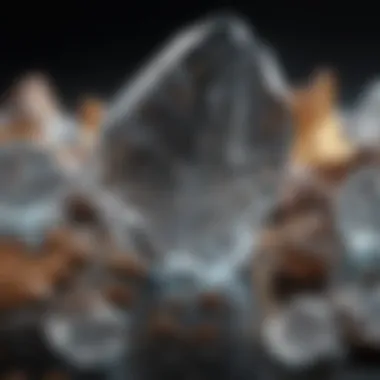
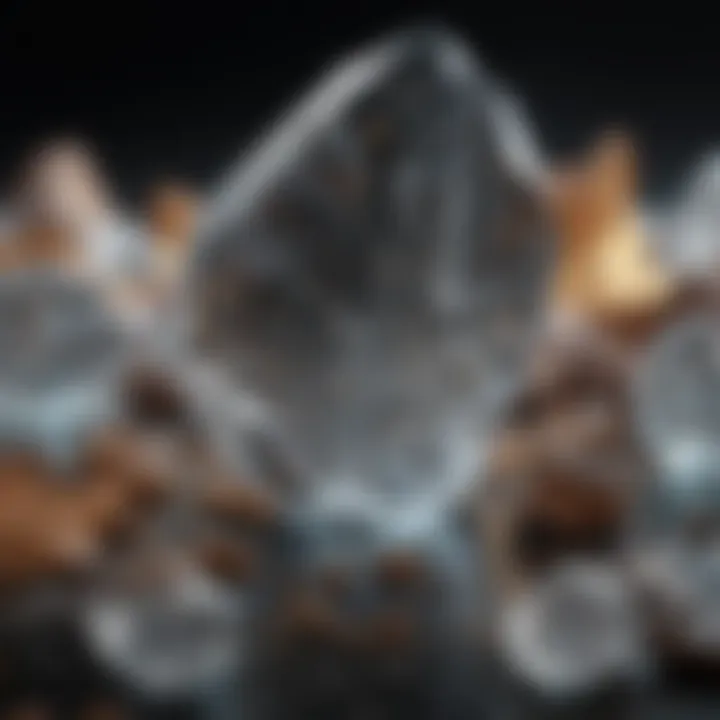
In summary, crystals might seem like mere geological oddities, but they embody essential features that power today's technology. With their applications spanning from piezoelectric devices to the very core of our electronic gadgets, understanding their relevance can enrich the appreciation for these natural wonders.
Industrial Applications of Crystals
The industrial applications of crystals play a pivotal role in our modern world, a fact that often goes unnoticed. These crystalline structures are not just pretty to look at; they are integral to various manufacturing and technological processes. Given their unique properties, crystals find utilization across industries, from consumer electronics to telecommunications. Understanding the impact of crystals in these sectors can not only foster appreciation among rock and fossil collectors but also underscore their vital role in our everyday lives.
Crystals in Manufacturing Processes
Crystals are the backbone of many manufacturing processes, particularly in sectors that require precision and reliability. One standout example is the use of quartz crystals in electronic devices. When quartz resonates at a specific frequency, it can be used to control the timing functions in devices like clocks and radios. This characteristic allows for extremely precise measurements and makes quartz a popular choice in the electronics world.
Another noteworthy point is the role of crystals in the creation of semiconductors. Silicon, a prominent crystal, forms the foundation of virtually all electronic devices. In fact, during the manufacturing of integrated circuits, silicon wafers are used to fabricate microchips that power everything from computers to smartphones. Without these crystal structures, the demands of today's technology could not be met.
Moreover, crystals like sapphire are extensively used for their hardness. Pebble-sized sapphire crystals are often utilized as substrates for LED lights, making them a critical component in modern lighting solutions. Instead of using easily breakable materials, manufacturers turn to crystals like sapphire for durability and efficiency.
"In the industrial realm, the integration of crystals ensures that our technological advances maintain precision and reliability, shaping how we interact with the world around us."
Role of Crystals in Optical Technologies
The optical properties of crystals open up a world of possibilities in technology and manufacturing. For instance, crystals like potassium titanyl phosphate (KTP) are essential in cutting-edge laser systems. These lasers find applications in various fields ranging from medical surgeries to manufacturing processes requiring precision cutting. The ability of these crystals to convert one wavelength of light to another makes them invaluable.
Crystals also contribute significantly to telecommunications. The advent of fiber optics has made it essential to understand how light interacts with different crystal structures. Optical fibers, bending light through microscopic crystal fibers, enable high-speed internet and clear communication worldwide. This advancement has led to an interconnected global community, demonstrating the broader societal impacts that crystals have on our daily lives.
In addition, many crystals exhibit a phenomenon known as birefringence, where they have different refractive indexes along different axes. This property is important in fields such as mineralogy, where understanding light behavior in crystals can aid in the identification of materials. The resulting technology powered by crystals has led to innovations that redefine communication and optics, echoing the ultimate potential of these natural formations to shape various industrial outcomes.
By exploring the industrial applications of crystals, it becomes evident that these natural wonders are far more than simple collector's items; they are vital resources driving modern advancement.
The Aesthetic Value of Crystals
Crystals possess a charm that goes well beyond their physical structure. Their aesthetic appeal is not merely a matter of shiny surfaces and vibrant colors; it delves into historical, cultural, and emotional dimensions that many collectors and enthusiasts value deeply. The beauty of crystals lies in their unique formations, hues, and the various meanings attributed to them across different societies.
Crystals in Jewelry Making
One of the most celebrated uses of crystals is in jewelry making. From the glimmering sparkle of a diamond to the soothing tones of an aquamarine, crystals can transform into wearable art. Jewelers have utilized various gems not just for their beauty but also for the stories and beliefs attached to them. For instance, a ring adorned with amethyst might not only catch the eye but also represents tranquility, providing the wearer with a sense of calm. Similarly, rose quartz earrings might make a lovely statement while also embodying love and compassion.
When selecting crystals for jewelry, artisans often consider their clarity, color, and the way light plays with their surfaces. Each gemstone has its own characteristics, making them suitable for different styles and settings. The value of crystals in jewelry transcends mere decoration; it often interweaves the personal sentiments of those who wear them, making each piece significant in a unique way.
"Jewelry has the power to be the one little thing that makes you feel unique."
This sense of individuality highlights why many collectors pour time and resources into finding the perfect stones. The hunt often leads them to local artisans or specialized shops where the craftsmanship reflects not only skills but also a passion for the material.
Home Decor and Crystals
Beyond personal adornment, crystals have made their way into home decor, enforcing their aesthetic relevance in everyday environments. Incorporating crystals into living spaces can bring a touch of elegance and a unique narrative to one's surroundings. Items such as geodes, crystal spheres, or even simple raw crystal clusters can serve as focal points in a room, captivating attention with their natural beauty.
Different crystals are believed to have specific energies that can influence the vibes of a place. For instance, placing a clear quartz in the living room is thought to promote clarity and positivity, while black tourmaline is favored for its purported protective qualities. Many enthusiasts curate spaces that highlight these beliefs, merging beauty with intention.
Moreover, the application of crystals in home decor isn't limited to simply placing them on shelves or tables. Crystals are often integrated into artistic pieces—think lamps made with amethyst, which not only illuminate a room but also emit a soft, calming glow.
As collectors become more knowledgeable and discerning, they appreciate the history and mythology attached to each crystal, which adds further layers to their aesthetic value. The existence of online platforms and communities allows individuals to share ideas and inspirations, opening avenues for creativity in ways previously unimagined.
In summary, the aesthetic value of crystals resonates deeply with both personal and collective narratives, making them a cornerstone in the realms of jewelry and home decor. Enthusiasts appreciate them not only for their beauty but for the meanings woven into their very being.
Collecting Crystals
Collecting crystals has become a popular pastime for many, not just for their visual appeal but also for the deeper meaning and significance they hold. Developing a crystal collection is more than merely amassing beautiful objects; it's a journey into the geological, historical, and cultural aspects of these natural wonders. An investment in crystals can bring joy and satisfaction while also expanding one’s knowledge about geology and metaphysical perspectives. Paying attention to collection standards, ethical sourcing, and proper care can significantly enhance the experience. This section explores the ins and outs of starting and valuing a collection, offering tips and insights for both novices and seasoned collectors.
Starting a Crystal Collection
Kicking off a crystal collection doesn’t have to be a daunting task. First things first, deciding what kind of crystals to focus on is crucial. Are you drawn to radiant formations, such as quartz or amethyst, or do you prefer the unusual allure of rarity like benitoite?
Consider the following steps:
- Research: Delve into the history and properties of various crystals. Websites like Wikipedia provide a wealth of information.
- Visit Local Shops and Markets: Exploring rock shops or gem fairs can yield some surprising finds. Don't hesitate to ask about the origins of crystals—ethical sourcing is key.
- Start Small: It’s not obligatory to begin with expensive specimens. Many collectors start their journey with tumbled stones or lower-priced crystals, gradually working their way up to more valuable pieces.
- Join Communities: Engaging with fellow enthusiasts on platforms like Reddit helps in sharing insights and obtaining valuable tips.
- Document Your Progress: Keeping a journal of your collection, including where each piece came from and its properties can add depth to your experience.
By piecing together these aspects, you can cultivate an impressive collection that tells a story about your journey as a collector.
Valuing Your Crystal Collection
Once your collection starts taking shape, the next logical question is, "How do I value my crystals?" The value can encompass both monetary and sentimental aspects.
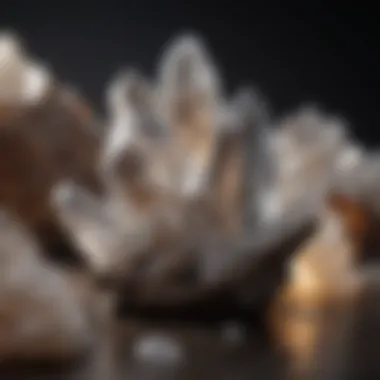
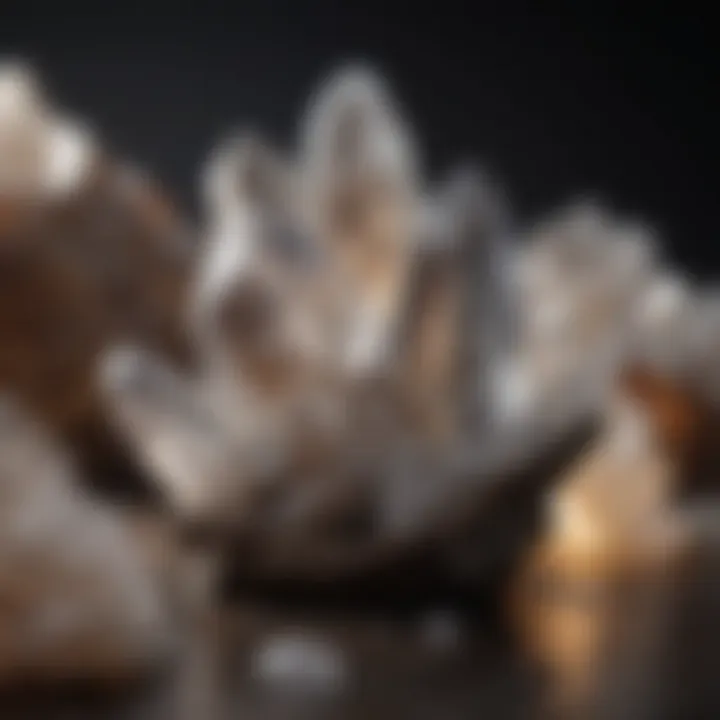
- Market Research: Understanding the current market trends is essential for assessing the value of your specimens. Price fluctuations can occur, often based on demand, rarity, and condition. Utilize online marketplaces and bidding platforms to gauge ongoing values.
- Condition and Quality Matters: Examine the physical condition of your crystals. Chips, cracks, or discoloration can diminish value. Clean your crystals carefully to present them at their best—just be cautious not to affect their integrity.
- Provenance: The history of a crystal can significantly impact its worth. Certifications or documents relating to authenticity, provenance, or notable ownership can add coins to the value.
- Gemological Certification: For crystals that are more valuable, getting them appraised professionally may be worth the effort. A certified gemologist can provide an objective valuation.
- Sentimental Value: Keep in mind that the most meaningful pieces may not carry the highest market value. Sometimes, a crystal gifted by a loved one or found during a significant experience is worth more than valuables merely collected for aesthetics.
"Crystals are like books—they hold stories, and every collector adds a chapter to their own narrative."
Cultural Perspectives on Crystals
Understanding the cultural perspectives on crystals offers a fascinating glimpse into how these natural formations impact human history and societies. Across the globe, crystals have not only been used for their physical properties but also embraced for their perceived spiritual strength. By exploring various cultural attitudes, we can appreciate the deep and often spiritual connection that different communities have with these beautiful minerals.
Crystals in Ancient Cultures
Crystals have been part of human civilization since time immemorial. In ancient Egypt, for example, lapis lazuli was often used in burial artifacts, believed to provide protection in the afterlife. The Egyptians, being among the earliest crystal users, connected the deep blue stone with the heavens and serendipity, using it in artifacts that adorned their pharaohs.
Similarly, in Chinese culture, jade holds a prominent place. The Chinese have cherished jade for its toughness and beauty. It symbolizes purity and moral integrity, often used in important ceremonial contexts. Carvings of jade, like dragons and other symbols, are believed to bring about good fortune and ward off evil spirits.
In the Americas, indigenous tribes harness crystals for spiritual purposes. Quartz crystals were utilized in rituals meant to facilitate communication with the spirit world. Such practices reflect an understanding of crystals as conduits for energies beyond our material existence.
"Crystals connect us to the Earth and to the stars, serving as a bridge between our environment and our spirit."
This belief in the energetic properties of crystals doesn’t stop at mere superstition. Cultures worldwide have experimented with different crystals, recording their effects on human well-being. The healing properties attributed to certain stones often stem from both observational experience and spiritual beliefs.
Modern Spiritual Movements and Crystals
In more recent times, modern spiritual movements have brought crystals back into the limelight. Following the New Age movement of the late 20th century, interest in crystals for personal development formed an essential component of many holistic practices. Today, people integrate crystals into Yoga, meditation, and mindfulness practices, emphasizing their potential to balance energies and enhance spiritual connection.
The popularity of crystals can also be seen through their increasing presence on social media platforms. Communities on Reddit and Facebook have sprung up, where enthusiasts share insights and personal stories about their journeys with stones.
Each crystal, from rose quartz to amethyst, carries its unique energy signature, leading to differing applications. Rose quartz, for instance, is often lauded for fostering love and emotional healing, while amethyst is said to enhance spiritual awareness and intuition.
Here are some key points about the modern perspective on crystals:
- The widespread belief in the energetic properties of crystals encourages individual empowerment and self-healing.
- Crystals play a role in many wellness products today, featuring in everything from skincare to wellness retreats.
- There exists a rich online culture where individuals can exchange knowledge and experiences, fostering global dialogue.
Crystals' roles in both ancient and modern contexts highlight their complex meanings, making them fascinating subjects for exploration. As we deepen our understanding of crystals, it becomes apparent that they are more than just geological formations; they are vessels for cultural identity and personal expression.
Environmental Considerations
The focus on environmental considerations within the realm of crystals is crucial for understanding the intersection between geological resources and ethical practices. As people increasingly turn to crystals for various purposes—be it healing, decoration, or technological applications—the impact on the environment and the ethics of sourcing these stones come to the forefront. Awareness of these factors can significantly influence both consumer choices and industry practices.
Ethical Sourcing of Crystals
Ethical sourcing is about more than just ensuring that crystals are collected responsibly; it also encompasses the human and environmental costs associated with their extraction. As collectors and enthusiasts, the notion of purchasing crystals that are harvested in an environmentally friendly and socially responsible manner can help mitigate negative impacts on ecosystems and local communities.
- Many crystals are sourced from developing nations where mining regulations can be lax. As collectors, one might look for vendors who can provide transparency about their supply chains.
- Certifications related to ethical practices can sometimes be sought. This might include looking for crystals that are certified by organizations focusing on fair trade or sustainable mining.
- Supporting small-scale miners who engage in responsible practices helps foster local economies while ensuring that the resources are harvested in a manner that does not lead to substantial ecological harm.
By choosing ethically sourced crystals, collectors can play a part in promoting sustainability within a market that thrives on the beauty of the Earth’s natural resources.
The Eco-Impact of Crystal Mining
The environmental consequences of crystal mining can range from the loss of biodiversity to significant landscape alteration. Understanding these effects is essential for enthusiasts who want to enjoy the aesthetic and perceived benefits of crystals while being mindful of their origins.
The mining process often leads to:
- Habitat destruction: Large areas of land can be cleared for mining operations, affecting the flora and fauna in those regions. This is particularly concerning in areas where rare plant or animal species reside.
- Soil erosion: Removal of plants and topsoil can lead to increased soil erosion, which not only affects the immediate site but can also contribute to downstream pollution and sedimentation in waterways.
- Water impacts: Mining operations frequently require significant water use and can lead to contamination of local water supplies with chemicals, affecting not just the ecosystem but local communities as well.
"Collecting crystals can be a rewarding hobby, but it is essential to consider the broader impact on our planet—after all, we share this Earth with countless species that depend on these ecosystems as much as we do."
Ending and Future Insights
Understanding the multifaceted uses of crystals is more than just a superficial exploration; it’s about connecting with history, science, and even spirituality. Crystals have held significance across cultures for millennia, acting as symbols of protection, healing agents, and even catalysts for technological advancements. Each crystal carries its own narrative, contributing not only to personal wellness but also to industrial applications that impact our daily lives.
The importance of this topic is multifaceted. From the ancient belief systems where crystals were tools of healing and magic to their undeniable role in modern technology—like quartz in watches or piezoelectric materials in advanced devices—crystals bridge the ancient and the modern. This connection further enhances their relevance today, especially among rock and fossil collectors, who often seek to unearth hidden meanings and uses behind each stone they acquire.
As society looks toward sustainability and eco-friendly solutions, the topic of ethical sourcing and the environmental impact of crystal mining becomes pressing. Collectors and enthusiasts alike will find this discussion crucial, as it not only ensures that their hobby aligns with their ethical values but also promotes a greater understanding of how such practices affect the planet and future generations.
The Evolving Role of Crystals in Society
In contemporary times, the role of crystals has transformed yet again. They’ve found a place within the wellness movement, with many individuals turning to crystals for their purported healing properties. From anxiety relief to spiritual cleansing, enthusiasts are employing crystals as tools for mental and emotional balance. The discussions surrounding these practices often highlight a blend of science and mysticism, calling for researched understanding of the properties attributed to various crystals.
Interestingly, the romantic allure of crystals can be seen in personal accounts and community forums, where individuals share their experiences with different stones, fostering a sense of belonging and shared knowledge. This evolving narrative reflects a society increasingly interested in holistic well-being amidst the chaos of modern life.
Suggestions for Further Exploration
For those captivated by the world of crystals and eager to deepen their understanding, several avenues are available.
- Join Local Crystal Groups: Connecting with others in the crystal community can provide valuable insight and shared experiences, along with valuable tips on sourcing and caring for crystals.
- Explore Online Platforms: Websites and forums like Reddit have dynamic threads where crystal enthusiasts discuss their discoveries, experiences, and even trade or sell crystals.
- Participate in Workshops: Local craft shops often hold workshops where beginners can learn about crystal healing practices, cleansing rituals, and more.
- Research on Ethical Practices: Look into responsible sourcing methods, ensuring that the collectibles you acquire do not perpetuate harm to the environment or exploit communities.
In short, the journey through the world of crystals is just beginning, with plenty to uncover. As the societal narrative continues to evolve, the relationship between humanity and these fascinating formations only deepens.



